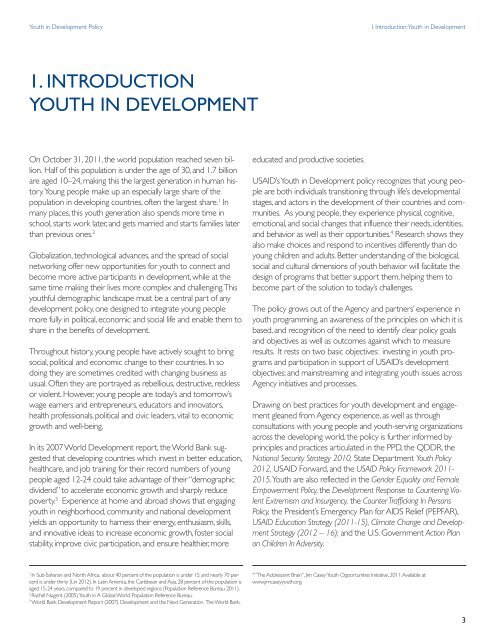YOUTH IN DEVELOPMENT Realizing the Demographic Opportunity USAID POLICY YOUTH
YOUTH IN DEVELOPMENT Realizing the Demographic Opportunity USAID POLICY YOUTH
YOUTH IN DEVELOPMENT Realizing the Demographic Opportunity USAID POLICY YOUTH
Create successful ePaper yourself
Turn your PDF publications into a flip-book with our unique Google optimized e-Paper software.
Youth in Development Policy I. Introduction:Youth in Development<br />
1. <strong>IN</strong>TRODUCTION<br />
<strong>YOUTH</strong> <strong>IN</strong> <strong>DEVELOPMENT</strong><br />
On October 31, 2011, <strong>the</strong> world population reached seven billion.<br />
Half of this population is under <strong>the</strong> age of 30, and 1.7 billion<br />
are aged 10–24, making this <strong>the</strong> largest generation in human history.Young<br />
people make up an especially large share of <strong>the</strong><br />
population in developing countries, often <strong>the</strong> largest share. 1 In<br />
many places, this youth generation also spends more time in<br />
school, starts work later, and gets married and starts families later<br />
than previous ones. 2<br />
Globalization, technological advances, and <strong>the</strong> spread of social<br />
networking offer new opportunities for youth to connect and<br />
become more active participants in development, while at <strong>the</strong><br />
same time making <strong>the</strong>ir lives more complex and challenging.This<br />
youthful demographic landscape must be a central part of any<br />
development policy, one designed to integrate young people<br />
more fully in political, economic and social life and enable <strong>the</strong>m to<br />
share in <strong>the</strong> benefits of development.<br />
Throughout history, young people have actively sought to bring<br />
social, political and economic change to <strong>the</strong>ir countries. In so<br />
doing <strong>the</strong>y are sometimes credited with changing business as<br />
usual. Often <strong>the</strong>y are portrayed as rebellious, destructive, reckless<br />
or violent. However, young people are today’s and tomorrow’s<br />
wage earners and entrepreneurs, educators and innovators,<br />
health professionals, political and civic leaders, vital to economic<br />
growth and wellbeing.<br />
In its 2007World Development report, <strong>the</strong>World Bank suggested<br />
that developing countries which invest in better education,<br />
healthcare, and job training for <strong>the</strong>ir record numbers of young<br />
people aged 1224 could take advantage of <strong>the</strong>ir “demographic<br />
dividend” to accelerate economic growth and sharply reduce<br />
poverty. 3 Experience at home and abroad shows that engaging<br />
youth in neighborhood, community and national development<br />
yields an opportunity to harness <strong>the</strong>ir energy, enthusiasm, skills,<br />
and innovative ideas to increase economic growth, foster social<br />
stability, improve civic participation, and ensure healthier, more<br />
educated and productive societies.<br />
<strong>USAID</strong>’sYouth in Development policy recognizes that young people<br />
are both individuals transitioning through life’s developmental<br />
stages, and actors in <strong>the</strong> development of <strong>the</strong>ir countries and communities.<br />
As young people, <strong>the</strong>y experience physical, cognitive,<br />
emotional, and social changes that influence <strong>the</strong>ir needs, identities,<br />
and behavior as well as <strong>the</strong>ir opportunities. 4 Research shows <strong>the</strong>y<br />
also make choices and respond to incentives differently than do<br />
young children and adults. Better understanding of <strong>the</strong> biological,<br />
social and cultural dimensions of youth behavior will facilitate <strong>the</strong><br />
design of programs that better support <strong>the</strong>m, helping <strong>the</strong>m to<br />
become part of <strong>the</strong> solution to today’s challenges.<br />
The policy grows out of <strong>the</strong> Agency and partners’ experience in<br />
youth programming, an awareness of <strong>the</strong> principles on which it is<br />
based, and recognition of <strong>the</strong> need to identify clear policy goals<br />
and objectives as well as outcomes against which to measure<br />
results. It rests on two basic objectives: investing in youth programs<br />
and participation in support of <strong>USAID</strong>’s development<br />
objectives; and mainstreaming and integrating youth issues across<br />
Agency initiatives and processes.<br />
Drawing on best practices for youth development and engagement<br />
gleaned from Agency experience, as well as through<br />
consultations with young people and youthserving organizations<br />
across <strong>the</strong> developing world, <strong>the</strong> policy is fur<strong>the</strong>r informed by<br />
principles and practices articulated in <strong>the</strong> PPD, <strong>the</strong> QDDR, <strong>the</strong><br />
National Security Strategy 2010, State Department Youth Policy<br />
2012, <strong>USAID</strong> Forward, and <strong>the</strong> <strong>USAID</strong> Policy Framework 2011<br />
2015.Youth are also reflected in <strong>the</strong> Gender Equality and Female<br />
Empowerment Policy, <strong>the</strong> Development Response to CounteringViolent<br />
Extremism and Insurgency, <strong>the</strong> CounterTrafficking In Persons<br />
Policy, <strong>the</strong> President’s Emergency Plan for AIDS Relief (PEPFAR),<br />
<strong>USAID</strong> Education Strategy (201115), Climate Change and Development<br />
Strategy (2012 – 16); and <strong>the</strong> U.S. Government Action Plan<br />
on Children In Adversity.<br />
1 4 In SubSaharan and North Africa, about 40 percent of <strong>the</strong> population is under 15, and nearly 70 per “The Adolescent Brain”, Jim CaseyYouth Opportunities Initiative, 2011.Available at<br />
cent is under thirty (Lin 2012). In Latin America, <strong>the</strong> Caribbean and Asia, 28 percent of <strong>the</strong> population is www.jimcaseyyouth.org.<br />
aged 1524 years, compared to 19 percent in developed regions (Population Reference Bureau. 2011).<br />
2 Rachel Nugent. (2005).Youth in A Global World. Population Reference Bureau.<br />
3 World Bank Development Report (2007). Development and <strong>the</strong> Next Generation. The World Bank.<br />
3


